World’s First Identification of the Gene Responsible for Plant Growth
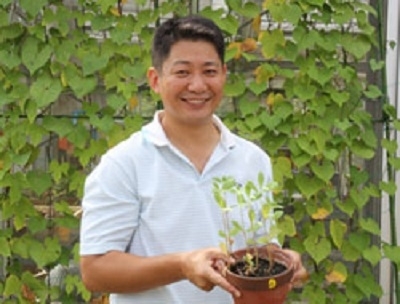
We talked to Associate Professor Tsuyoshi Furumoto, Laboratory of Plant Molecular Physiology, Graduate School of Science.
(September 16th, 2011, Interviewed by the Community Collaboration and Information Policy Office)
Overview
Dr. Tsuyoshi Furumoto is an associate professor at the Graduate School of Science’s Laboratory of Plant Molecular Physiology. He conducted a research along with Assistant Professor Masaki Shimamura and other specialists in the same field. His research outcome on chloroplasts was published August 25, 2011 in the English scientific scholarly journal “Nature”. Associate Professor Furumoto’s achievement is the world’s first identification of the gene that is responsible for the transport of pyruvic acid into the chloroplast. Pyruvic acid plays a major role in the metabolism within the chloroplast. This research shows the transport mechanism of pyruvic acid and is expected to be practically applied to biotechnology.
For the online edition of the scientific scholarly journal “Nature” click here.
The word “chloroplast” is well known and even appears in elementary school science lessons. We interviewed Associate Professor Furumoto about the leading edge-research in this area.
Not photosynthesizing chloroplasts?
Associate Professor Furumoto’s major is plant physiology, especially photosynthesis within the chloroplast, an issue he’s already researched about for many years.
The function of the chloroplast is photosynthesis with the help of light and carbon dioxide in order to produce the nutrients necessary for plant growth. - At least many people imagine that it works like this.
But Associate Professor Furumoto says that this is not the whole of the story!
There are two types of plants: C3 plants that perform C3-type photosynthesis and C4 plants performing C4-type photosynthesis. The letter “C” stands for “carbon atom”. The numbers 3 or 4 indicate the quantity of carbon atoms, which metabolites were firstly produced by the carbon dioxide fixation during photosynthesis. That means that C4 plants has a distinguishable metabolism, in which four carbon chemical is the initial metabolite and this metabolism achieved to concentrate carbon dioxide causing more efficient photosynthesis. To give some well-known examples: Rice and wheat are C3 plants, sugarcane, corn and major weeds are C4 plants.
What’s the difference between the photosynthesis cycles of these two types of plants?
In case of C3 plants, photosynthesis is performed in every chloroplast. On the other hand, C4 plants have two varieties of chloroplast: [1], which is for photosynthesizing and [2], which is only for functioning for carbon-dioxide-concentration metabolism without photosynthesizing by itself. [2] is very active, sending a large amounts of carbon dioxide to [1], and compared to C3 plants, C4 plants are able to retain as much as 70 times the carbon dioxide concentration. Therefore, C4 plants have a much higher photosynthetic capability than C3 plants and grow much faster.
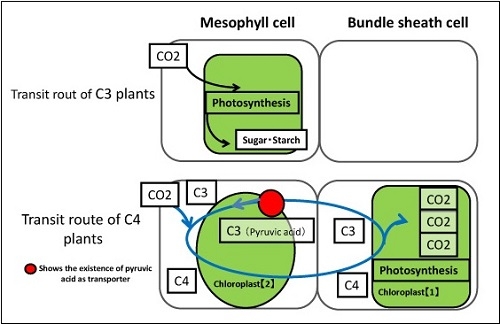
The photosynthesis cycles of C3 and C4 plants. The blue cycle indicates the transporting route of CO2.
Who hasn’t had the experience of pulling weeds completely out before planting a crop, only to have them suddenly spread and grow faster than the crop? This happens because many kinds of weed are C4 plants with a particular CO2 transporting route. Associate Professor Furumoto says that every plant is suffering from a lack of CO2. With the recent calls for CO2 reduction, I was surprised to hear that.
World’s first identification of the pyruvic acid transporter!
What’s the secret of C4 plants’ ability to actively photosynthesize and to retain a carbon dioxide concentration as much as 70 times higher than C3 plants?
A substance called pyruvic acid is responsible for the transport of carbon dioxide between the chloroplast [1] and [2]. Studies have shown that the help of “something” is necessary to cross the membrane of the chloroplast and to enable the transport of pyruvic acid in order to transport CO2. The identity of this “something” has been unknown for many years and became a big barrier to progress for scientists.
Associate Professor Furumoto and his research team succeeded in identifying this “something” for the first time in the world by using a certain plant for their experiments.
The plant, they used, was Flaveria. Within the genus Flaveria, there are 21 variations, ranging from C3 to C3-C4 intermediate to C4 plants. Therefore, Flaveria is ideal for a comparative investigation on the photosynthesis cycle. You could search the world and almost never find a plant such as Flaveria that shows the situation before and after its particular evolution at the same time. It’s a plant of rare value.
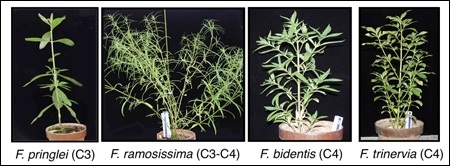
Species of Flaveria
After some time of consideration, comparing the gene sequences etc., Associate Professor Furumoto decided to use Flaveria for his experiments.
Associate Professor Furumoto says: “Finding this plant was a big step for our research and the key for our success.”
The results of the gene expression analysis of Flaveria showed that in addition to other, already known genes that are important for the C4 photosynthesis, there was a large number of a certain gene detected, which was named “BASS 2”. Then, other C4 plants were tested and it could be proved that BASS 2 was the essential substance, responsible for the transport of pyruvic acid!
Encountering an essay, determining the research’s direction
At Kyoto University, Associate Professor Furumoto studied botany. While in college, he encountered an essay that would completely change his future research career.
The essay was written by Professor Ryuji Kanai, who was at that time a researcher of photosynthesis at Saitama University (retired in 1999). His work was revolutionary in the field, as he succeeded in developing a technology to separate the cells of corn into mesophyll cells and bundle sheath cells.
Associate Professor Furumoto thought to combine this technology with molecular biological methods, his area of specialty. So, this encounter determined his future career options.
However, the identification of the pyruvic acid transporter to the chloroplasts, Associate Professor Furumoto’s research topic, was still unexplained and feared by scientists so there were few preceding studies. - And the research content was completely different from what was done in his laboratory at that time.
All the same, Associate Professor Furumoto was honest about his interest, and decided to continue researching.
Hiroshima University made it possible
Specialized equipment is often needed for an experiment.
When Associate Professor Furumoto’s research reached a certain level, he attempted to install the same research equipment as Saitama University, into his own laboratory. As he had some interchange with Saitama University, he borrowed some of the equipment from there and had it estimated by a dealer. To order “just the same one,” he surprised to hear that it cost 400,000 yen. In those days, that sort of money went over budget. “No chance”, he thought and was at the point of giving up. In a last-ditch bid, he knocked on the door of the Hiroshima University Metal Processing Factory and asked whether he could order it. The answer was that they could make it for only several thousand yen! And they did it precisely even without the use of a blueprint.
“Being able to provide the necessary equipment by one’s own self is very reassuring for a researcher,” said Associate Professor Furumoto.
Another piece of indispensable equipment for a biochemical analysis experiment is a RI ( radioisotope ) experiment facility. This equipment achieved the trace of radio-labelled pyruvate analysis. Which is why this equipment is quite rare in Japan. Even among State Universities, the number of institutes that possess it is very limited. At the Hiroshima University Natural Science Center for Basic Research and Development, Isotope Department, such RI equipment was installed. It is necessary for various experiments, and everybody affiliated with the university enjoys free access.
Associate Professor Furumoto had shut himself in in the low temperature laboratory during the experiment. He said that he has never seen such a large low temperature laboratory at any other university. In addition, the RI experiment facility there was extremely well developed, and there was a lot of useful measuring equipment to accurately gauge the amount of the transported radio-labelled pyruvic acid.
Associate Professor Furumoto said: “Both the support of the metal processing factory and also of the use of the RI equipment, were essential for the success of my experiment. Only Hiroshima University had this big advantage.”
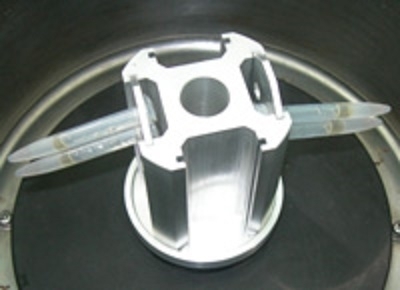
The metallic equipment made by the Hiroshima University metal processing factory. It was essential for the success of the experiment.
Clarifying the evolution process of plants
After he published the results of many years’ worth of research, Associate Professor Furumoto’s plan for the future is to clarify the evolution process of C3 to C4 plants. Then, it would be possible to evolve the C3 photosynthesis cycle to a C4-type one. The research results will possibly be applied to biotechnology in order to accelerate the growth of plants etc.
To give an example: A third of the world’s total staple food production consists of rice. Rice is a C3 plant. If it was possible to accelerate the growth of rice, an increase in crop yields could be expected, which would be a big contribution to alleviate future world food shortage.
Associate Professor Furumoto was vocal about his commitment to research: “I think that in response to the publication of my study outcome, research will proceed all over the world. Among them, I want more pragmatic research done; unique and full of originality.”
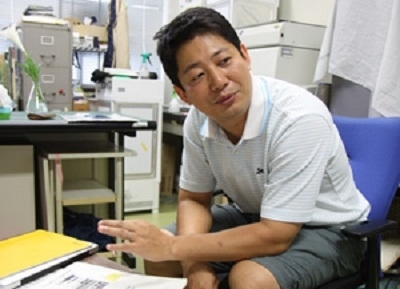
Associate Professor Furumoto, talking about the future outlook of his research
Postscript
Although photosynthesis is a topic covered in science classes at school, there are still mechanisms that are yet-to-be-defined!
At times when I seemed confused by his explanations, Associate Professor Furumoto explained everything in detail, giving analogies as he spoke. The more I heard about it, the more I thought that these research results published now belong to a far-away micro-world, but when I heard Associate Professor Furumoto’s global vision that they may contribute to overcome the world’s food shortage, I was very impressed to see what a broad perspective he has.
Another possible practical application of biotechnology is not to accelerate but to hinder the growth of plants. In the near future, it may be possible to keep our gardens and fields clear of weeds without the need to regularly pull them out. (S)


 Home
Home

